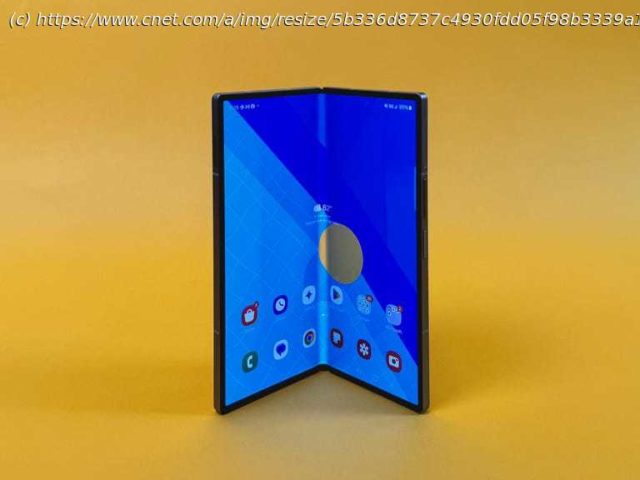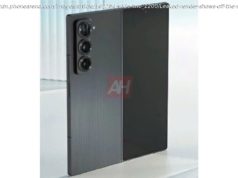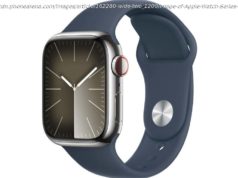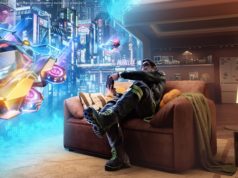The Galaxy Z Fold 6’s high price holds it back. Plus, I want more software features that make use of the phone’s unconventional shape.
Samsung Galaxy Z Fold 6 Pros
Larger and more symmetrical front screen
Improved design with less crease
Inner screen is among the best on a foldable phone
Better ultrawide camera
7 years of software upgrades
Cons
$100 more expensive than the Galaxy Z Fold 5
No major improvements to charging speeds or battery life
Most new software features aren’t specific to foldable design
With the Galaxy Z Fold 6, Samsung finally achieved its goal of making a foldable that can truly replicate the experience of a traditional phone while doubling as a sleek tablet. Roughly five years after the original Galaxy Fold’s launch, Samsung’s book-shaped device has gotten lighter, slimmer, more durable and natural to use as a phone; a seemingly mundane but necessary improvement.
The Galaxy Z Fold 6’s new design, clearly inspired by the Galaxy S24 Ultra, is its most striking upgrade. Samsung has also thrown in some new AI-powered software features, an ultrawide camera sensor that’s better at capturing photos in the dark and a fresh processor to match the one inside the Galaxy S24 lineup.
Unfortunately, those upgrades come at a cost: $1,900 to be exact. Samsung’s already expensive foldable phone is $100 pricier than it was last year, proving that the Galaxy Z Fold is indeed a luxury device. The Galaxy Z Fold 6’s svelte build is a step forward, but Samsung’s price hike feels like a step backward, especially since the company introduced significant changes like a new hinge and a lighter design without raising prices in years past.
I’ve been enjoying using the Galaxy Z Fold 6, and I can see why it can be hard to go back to a regular phone once you’ve used it. Samsung also hasn’t provided the two biggest things I’m looking for in tablet-style foldable phones: more affordable prices and innovative software that makes better use of their dual screens. Instead, the Galaxy Z Fold 6 feels like an attempt to bring foldables up to speed with regular phones in areas like design and camera quality — a modest step forward rather than a major leap forward.Galaxy Z Fold 6 design and display
The Galaxy Z Fold 6 is lighter than last year’s phone.
The Galaxy Z Fold 6 has no problem masquerading as a regular phone when closed. Not only is the cover display slightly larger (6.3 inches versus 6.2 inches on the Z Fold 5), but the borders framing the screen are more symmetrical. The corners of the phone have a sharper and more angular look, much like the Galaxy S24 Ultra.
Taken together, these changes make the Galaxy Z Fold 6’s exterior look less like a cover screen and more like a regular standalone phone. It’s not just about how the phone looks; the flatter edges are easier to grip, and the roomier display provides a slightly bigger canvas for taking photos while the phone is closed. The Galaxy Z Fold 6 is also about 14 grams lighter than the Galaxy Z Fold 5, and the difference is noticeable as soon as you pick it up. It also has a durability rating of IP48 unlike previous Folds, meaning it should have some protection against foreign objects like debris in addition to water resistance.
The Galaxy Z Fold 6 (left) next to the Galaxy Z Fold 5 (right).
Such changes are necessary for Samsung to compete with the $1,800 Google Pixel Fold and $1,700 OnePlus Open, both of which have wider outer displays meant to make their respective phones feel easy to navigate when closed. I used to prefer the Pixel Fold’s wider shape when closed over the Z Fold’s, but the Z Fold 6 feels like the right combination of being expansive enough to avoid compromising the phone experience without feeling too broad.
The internal tablet-sized screen still measures 7.6 inches like that of the Z Fold 6’s predecessors. The crease is slightly less noticeable this time around thanks to an additional display layer and a more durable hinge. The new sharper corners also give the Z Fold 6 a cleaner and more streamlined look when opened, sort of like that of a sheet of paper or an e-reader.
The Galaxy Z Fold 6’s flatter edges give the device a sleeker feel.
Roaming around Paris, the Galaxy Z Fold 6’s spacious screen came in handy for viewing Google Maps and browsing photos taken while wandering the city on a larger display. Although I usually prefer to dedicate the entire internal screen to one app, split screen mode was surprisingly useful while traveling, particularly for pulling restaurant recommendations from a chat in WhatsApp and plugging them straight into Google Maps without having to switch between apps.Galaxy Z Fold 6 AI and software features
The Galaxy Z Fold 6 comes with some new AI software features.
Samsung, like the rest of the tech industry, is enamored with generative artificial intelligence, and it’s looking for new ways to implement the technology in its most important products.
The Galaxy Z Fold 6 and Galaxy Z Flip 6 are the company’s latest attempt to do just that with new features that recast selfies in different artistic styles, generate full images from rough sketches, leverage both of the Z Fold’s screens to translate conversations and more. That’s in addition to existing features for erasing objects from photos, summarizing notes, translating phone calls in real-time, and searching Google just by drawing a circle around an object on the screen.
Portrait Studio, the tool that stylizes photos of people, is a lot of fun to play around with. I went down a rabbit hole transforming selfies into 3D cartoons, watercolor paintings and sketches, full of curiosity about how Samsung’s AI would interpret my images. Sometimes the results were flattering and somewhat accurate; other times they were unrecognizable. A cartoon version of me, for instance, had blue eyes even though my eyes are brown.
Samsung’s Portrait Studio tool turns selfies into artwork, but not all the results looked like me.
Sketch to Image, as its name implies, can generate a picture in a specific style based on a drawing. I’m a terrible artist, so my sketches are in much need of refinement. Like Portrait Studio, Sketch to Image was somewhat inconsistent but still a lot of fun.
Sometimes I was impressed by the results, as was the case when the phone morphed my barebones drawing into a watercolor painting of the Eiffel Tower.






